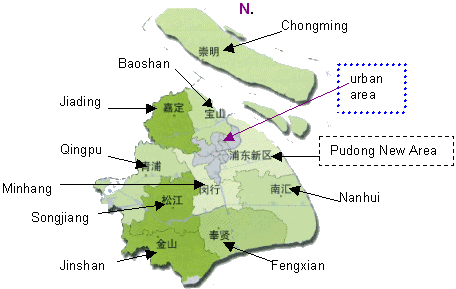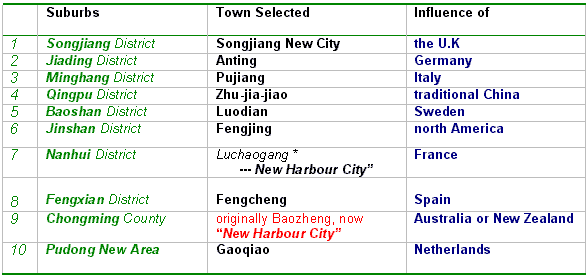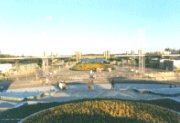|
"SATELLITE CITIES" SHINING IN SHANGHAI'S FUTURE
- SHANGHAI'S URBANISATION PROGRAM BEING REVIVED
I. Urbanisation: another theme for modernisation
China Daily reported on September 4, 2001 that Shanghai had hosted the
China Urbanisation Forum the day before. On that occasion, the result of the 2-year research on China's urbanisation policy, jointly conducted by the
Department of Regional Economy of the State Development Planning Commission of China and the
Japan International Co-operation Agency was released.
At the meeting attended by experts from mainland China, HKSAR and Japan, a prevailing view was that modernisation cannot be achieved simply by reaching an index-set target or by relying on industrialisation and that China's failure in modernisation pursue was mainly attributed to the insufficient attention to urbanisation.
China Daily commented that Shanghai, chosen as the forum venue, has been regarded as one of the biggest metropolises and expected to play a more important role in the country's urbanisation.
II. The Urbanisation Scheme of Shanghai
1. Urbanisation - Core of City's New 20-Years Planning
The suburbs in Shanghai refer to one county Chongming, eight districts
Nanhui, Fengxian, Baoshan, Minghang, Jiading, Jinshan, Songjiang,
Qingpu, and the rural part in Pudong New Area. Shanghai, including the urban and suburban parts, has a total area of 6'340.5 km 2 with a population of 13.2163 million people, while its suburbs cover an area of 6'000 km2 and are inhabited by 6.8 million people. (Please see the map below and
Annex 1 for more information.)

As early as twenty years ago when the Shanghai municipal government developed the overall city planning, it also took into account how to improve the living standard and economic strength of the rural areas. Phrases like "core towns" and "satellite cities" were put forward in the proposal and stood for the towns which would play a leading role in the development of the suburbs.
Through the years, the infrastructure network in the suburbs has been improved consistently with the construction of various networks of roads, telephone, water and electricity supplies. More and more public facilities such as hospitals and schools were built for the convenience of suburban residents. It is estimated that the permanent population in the towns has grown to 47% of the total population of the whole suburbs in Shanghai.
Although farmers in Shanghai are getting richer, the quality of the community has not improved so much. So far, the suburbs are divided into four administrative sub-levels, namely towns
(zhen  ), townships (xiang ), townships (xiang  ), neighbourhood committees
(jumin weiyuanhui ), neighbourhood committees
(jumin weiyuanhui  ) and villages committes
(cunmin weiyuanhui ) and villages committes
(cunmin weiyuanhui  ). The towns are randomly located. Out of the 200 towns, some are only with 5 km distance among one another while some are scattered over a vast expense. As the division criteria is subject to change while urbanisation is progressing, the sizes of the suburban administrative units are being restructured as well. (Please see in the
Annex 1 the change of the number of towns between 1999 and 2000.) ). The towns are randomly located. Out of the 200 towns, some are only with 5 km distance among one another while some are scattered over a vast expense. As the division criteria is subject to change while urbanisation is progressing, the sizes of the suburban administrative units are being restructured as well. (Please see in the
Annex 1 the change of the number of towns between 1999 and 2000.)
During the inspection tour to the suburbs in September 2000, Executive Vice Mayor of Shanghai Mr. Cheng Liangyu pointed out that "the suburbs of Shanghai lack characteristics and do no look as nice and colourful as its urban area". This message was transmitted to the planning authority to elaborate this topic in the"
Overall Urban Planning of Shanghai
(2001-2020)". Thus, the final version now reveals the new prominence in the city's development.
The main aim of the blueprint consists in making rational use of resources and space. The major issue is to speed up the urbanisation of suburbs. Suggested by vice mayor Chen, several towns are selected as the first step to pioneer the urbanisation project. The move is called
"One City Nine Towns".
2. Foreign Participation
Professor Zheng Shiling, vice president of the Architectural Society of
China, is the key advisor to the city's urban planning authority. "From the very beginning, we (members of the advisory group) were determined not to copy Disney Land. If the government decides that the suburban environment and architecture shall bear the influence of a certain country or region, we all agree that it's better to directly invite the overseas architects to make the planning and design."
It's not the first time that foreign architects have participated in planning the city's projects. Shanghai's Pudong New Area, which was mere farm land before the large-scale development started in 1990, has witnessed a few successful examples of foreign architectural design participation, such as the general planning for Lujiazui Development Zone, Shanghai Stock Exchange Buildging and the Century Boulevard and Century Park neighbouring the Scientific and Technology Centre, a key venue of the APEC 2001. Foreign participation in the planning is not only a show-case business for the architectural design institutes but can also benefit the local projects with an original perception and creative concept.
In principal, it is hoped that the design or planning of the urbanisation program should not only reflect the architectural characteristics of that selected country but should also fit in the ecological and cultural conditions of the local surroundings," Prof. Zheng told the undersigned.
As for the criteria for choosing the architectural style of a certain country, Prof. Zheng admits with a little smiling, "It's just decided by the authority and then you can find a reason for the choice. For example, since Volkswagen JV is located in
Anting town, so naturally the overall planning of Anting is according to a German style. The same rule applies to
Luodian, where Swedish Volvo is present. " (Please refer to Annex
2: an overview table of the selected ten towns.)
 Take
Songjiang New City as an example. In the long run, it will become a medium-level city with an area of 60 km2 to accommodate 500,000 dwellers. While rounded by the
Songjiang Industrial Zone, the Songjiang Universities'
Land, the Sheshan Scenic Spot and a few historic towns, the new city is divided into two parts in the south and north by the
Shanghai-Hangzhou Highway. The 22.4-km2 northern wing is set as the lead in the short term and construction started in mid-August. The first phase will mainly consist in building infrastructures and ameliorating environment and surroundings until the end of 2002. In the second phase from 2003 to 2004, tasks will be emphasised on developing residential facilities and public utilities. Take
Songjiang New City as an example. In the long run, it will become a medium-level city with an area of 60 km2 to accommodate 500,000 dwellers. While rounded by the
Songjiang Industrial Zone, the Songjiang Universities'
Land, the Sheshan Scenic Spot and a few historic towns, the new city is divided into two parts in the south and north by the
Shanghai-Hangzhou Highway. The 22.4-km2 northern wing is set as the lead in the short term and construction started in mid-August. The first phase will mainly consist in building infrastructures and ameliorating environment and surroundings until the end of 2002. In the second phase from 2003 to 2004, tasks will be emphasised on developing residential facilities and public utilities.
Preferential policy of the municipal government will guarantee the urbanisation program an allocation of start-up capital of RMB 200 million to 300 million (USD 24.4 million to 36.3 million) for each of the selected towns. All the efforts prove that the city attaches great importance to the urbanisation program. Mr. Huang Ju, the Party Secretary of the municipal communist party commission, clearly projects the prospects of the city's Tenth Five-year Plan as "the downtown area still holding the spotlight in the first two years, but later the suburbs will become the highlight of the city ."
III. The Role Switzerland Can Play in the Program
In the initial stage of Shanghai's urbanisation scheme, Switzerland was apparently neglected even though the selection criteria of the foreign participation is basically arbitrary. The Shanghai planning authority seems to have two main concerns in this regard. First of all, to the city's urban planning advisory committee, Switzerland is not considered to have its own unique architectural style. Instead, the city believes Swiss architecture to be part of the European style, generally speaking. Japan was not chosen either since its style is thought to fall in the same category of oriental style as China does. The advisory committee obviously has limited knowledge about Swiss architects with the exception of Mario Botta, who once exhibited his work in Shanghai in co-operation with Tongji University. But again Mario Botta is not considered Swiss but Italian.
Nevertheless, it is suggested that a list of famous Swiss architects and their contact information is collected and provided to the
Shanghai International Bidding Co., Ltd. Hence, in the future, more Swiss architects can be approached and invited to bid for other projects. In this respect, Professor Zheng is the person to contact. (Please refer to
Annex 3.)
However, it does not mean that Switzerland can not be involved in the current urbanisation program in any other way. A regional development plan will trigger the need for various products and services besides the architectural design itself. Following the planning framed by the municipal government, the local authority in these suburban districts and counties will implement the specific operations and constructions. Interested parties should like to contact the district-level governments. For the sake of easier communication, it would be also practical to first get in touch with the following main relevant municipal departments of Shanghai. (Please refer to
Annex 4.)
IV. Summary
To many foreigners, it is not a surprise any more to see new buildings for various purposes spring up in Shanghai. However, one may find the city is tightening the construction in the downtown area. The theme presented by Shanghai in its bid for hosting the
World Expo 2010 is "Better Life, Better City". To some extent , it reflects the city's awareness of limited resources and space. The accent is on sustainable development. Therefore, the city has reviewed the urbanisation scheme to expand the urban area and modernise its suburbs, illustrated in the city's overall planning.
In the first phase of the urbanisation program, Switzerland was not given enough attention in terms of the bid for environmental planning and architectural design. But there are still chances to strengthen the Swiss presence. First, the city urbanisation committee would like to know more about Swiss architects. Moreover, the program indicates an attractive market need for many kinds of building material and products. There Swiss business can compete for a better involvement in the program.
| October 8th, 2001, Shanghai
|
Freda Wang
Commercial Officer
|
* * *
Annex 1: Facts Glimpse of Shanghai Suburbs (figures source: Statistical Year Books of Shanghai 2000 & 2001)
|
Suburbs
|
Area
km2
|
Registered Population
|
Number of Towns
|
Address of the
District / County
Government
|
|
Jiading
|
458.8
|
475'500
|
17 (in 1999)
9 (in 2000)
|
No.111,Bo Le Rd.(S), Jiading District 201800
tel. +86-21-5953 0799
fax.+86-21-5952 9534
magistrate: Mr. Jin Jianzhong
|
|
Songjiang
|
604.7
|
492'800
|
20
(in 1999)
11 (in 2000)
|
No.38, Zhongshan Rd.
(M), Songjiang District 201600
tel. +86-21-5782 2845
fax.+86-21-5782 3475
magistrate: Mr. Pan Longqing
|
|
Minghang
|
371.7
|
617'500
|
15
(in 1999)
9 (in 2000)
|
No.6258, Huming Rd., Minghang District 201100
tel. +86-21- 6412 0682
fax.+86-21- 6412 1919
magistrate: Mr.Wang Hongquan
|
|
Baoshan
|
415.3
|
776'600
|
14 (in 1999)
14 (in
2000)
|
No.161,
Youyi Zhi Rd., Baoshan District 201900
tel. +86-21- 5669 1011
fax.+86-21- 5678 2427
magistrate: Mr. Xu Jianguo
|
|
Jinshan
|
586
|
532'700
|
1
(in 1999)
15 (in 2000)
|
No.429 We Er Rd., Jinshan District 200540
tel. +86-21- 5795 9250
fax.+86-21- 5795 4442
magistrate: Mr.Li Jinsheng
|
|
Qingpu
|
675.6
|
454'900
|
20
(in 1999)
12 (in
2000)
|
No.100 Gongyuan Rd.,
Qingpu District 201700
tel. +86-21- 5742 0017
fax.+86-21-
5742 0910
magistrate: Mr. Chao Weilin
|
|
Nanhui
|
687.7
|
691'100
|
25
(in 1999)
24 (in
2000)
|
No.52, Renmin Rd., Huinan Town, Nanhui County, 201300
tel. +86-21- 5795 9250
fax.+86-21- 5795 4442
manzhao@online.sh.cn
magistrate: Mr. Chen Dechang
|
|
Fengxian
|
687.4
|
504'600
|
22 (in 1999)
22
(in 2000)
|
No.502
Jiefang Rd.(M), Nanqiao Town, Fengxian District 201400
tel.
+86-21- 5742 0017
fax.+86-21-
5742 0910
magistrate:
Mrs. Shen Huiqi
|
|
Chongming
|
1041.2
|
663'300
|
20 (in 1999)
13 (in
2000)
|
No.34
Renmin Rd., Chenqiao Town, Chongming County 202150
tel. 86-21-59622324
fax. 86-21-59621500
magistrate: Mr. Gu Guolin
|
|
Pudong New Area
|
522.8
|
1'600'000
|
26 (in 1999)
13 (in 2000)
|
141 Pudong
Ave., Shanghai 200135
tel.
+86-21- 5878 8388
fax.+86-21-
5876 9692
magistrate:
Mr. Hu Wei
|
| |
|
| Annex 2: List of the 10 Towns To be Urbanized with Priority |
Back
to text |

| Annex 3: Contact Numbers of Prof. Zheng Shiling |
Back
to text |
| |
|
DOSSIER OF PROF. DR. ZHENG SHILING
- Director, The Committee of Urban Space and Environment,
The Urban Planning Commission of Shanghai Municipal Government
- Director, Institute of Architecture and Urban Space, Tongji University
- Membre de l' Académie d' Architecture de France
- Vice President, The Architectural Society of China
- President, The Architectural Society of Shanghai
 +86-21-6598 3863
+86-21-6598 3863  +86-21-6598 5216 email: shiling@mail.tongji.edu.cn
+86-21-6598 5216 email: shiling@mail.tongji.edu.cn
|
| |
|
Annex 4:
Contact Numbers of Related Departments
of the Shanghai Municipal Government |
Back
to text |
| |
|
- Shanghai Urban Planning & Administration Bureau
2431 Xie Tu Rd., Shanghai 200030
Tel. +86-21-6427 1866
Director: Mrs. Xia Liqing
Deputy Director: Mr. Tang Zhiping
- Foreign Co-opeation Division,
Shanghai Municipal Agriculture Commission
200 People´s Ave., Shanghai
Div. Chief: Mr. Li Weiliang
Dive. Vice Chief: Mrs. Ang Jinlian
Tel. +86-21- 6311 9636
Fax. +86-21-6358 4532
|
|
P.S. Agriculture Commission is responsible for not only the city's argiculture business, but also the macro-economic development of the suburbs including the secondary and tertiary industries.
Foreign Co-operation Division,
Shanghai Municipal Construction Commission
Rm.1513, 200 People´s Ave., Shanghai 200003
Tel. +86-21-6311 9718
Fax +86-21-6323 3406
Deputy chief: Mr. Dong Shouqin
|
30.10.2001
Consulate General of Switzerland
for business related matters, please reply: sha.vertretung@eda.admin.ch
|

![]()




 Take
Songjiang New City as an example. In the long run, it will become a medium-level city with an area of 60 km2 to accommodate 500,000 dwellers. While rounded by the
Songjiang Industrial Zone, the Songjiang Universities'
Land, the Sheshan Scenic Spot and a few historic towns, the new city is divided into two parts in the south and north by the
Shanghai-Hangzhou Highway. The 22.4-km2 northern wing is set as the lead in the short term and construction started in mid-August. The first phase will mainly consist in building infrastructures and ameliorating environment and surroundings until the end of 2002. In the second phase from 2003 to 2004, tasks will be emphasised on developing residential facilities and public utilities.
Take
Songjiang New City as an example. In the long run, it will become a medium-level city with an area of 60 km2 to accommodate 500,000 dwellers. While rounded by the
Songjiang Industrial Zone, the Songjiang Universities'
Land, the Sheshan Scenic Spot and a few historic towns, the new city is divided into two parts in the south and north by the
Shanghai-Hangzhou Highway. The 22.4-km2 northern wing is set as the lead in the short term and construction started in mid-August. The first phase will mainly consist in building infrastructures and ameliorating environment and surroundings until the end of 2002. In the second phase from 2003 to 2004, tasks will be emphasised on developing residential facilities and public utilities. 